Send task approvals using activity feed notification (Graph APIs)
This sample shows a feature where:
- Requester : Can request for any task approval from manager by sending activity feed notification and can see his request status.
- Manager : Can see the pending approval request raised by user on the click of activity feed notification and can approve or reject the request.
Included Features
- Teams SSO (tabs)
- Activity Feed Notifications
- Graph API
Interaction with app
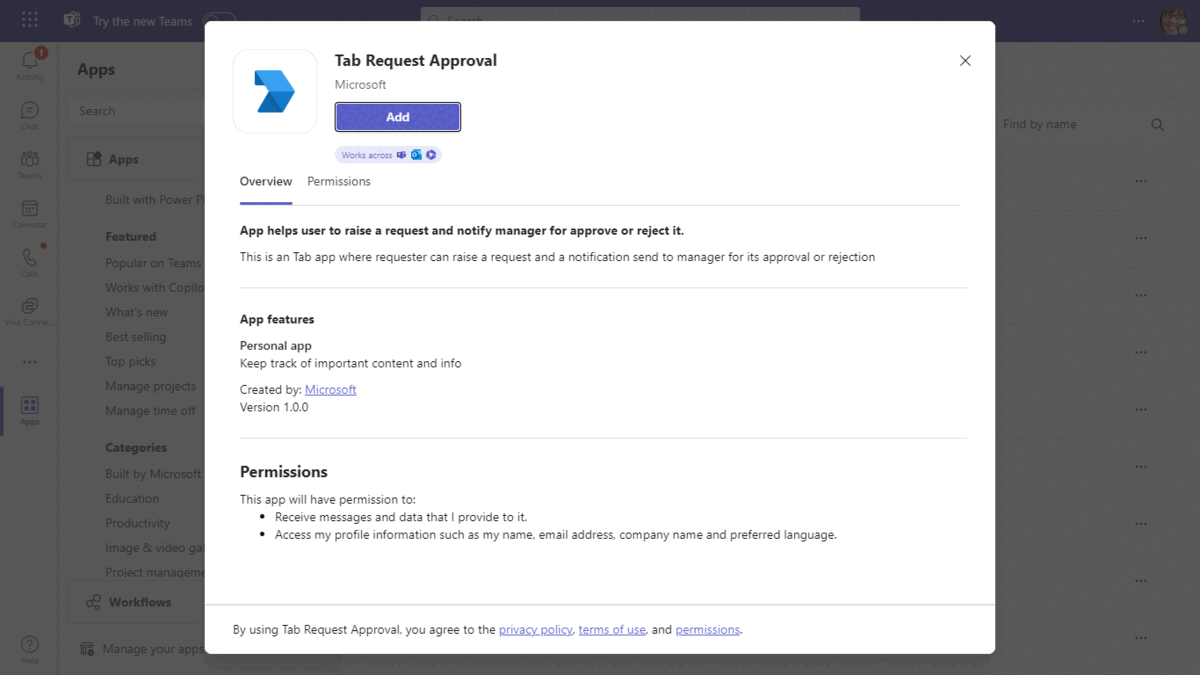
Try it yourself - experience the App in your Microsoft Teams client
Please find below demo manifest which is deployed on Microsoft Azure and you can try it yourself by uploading the app package (.zip file link below) to your teams and/or as a personal app. (Sideloading must be enabled for your tenant, see steps here).
Send task approvals using activity feed notification: Manifest
Prerequisites
.NET Core SDK version 6.0
determine dotnet version
dotnet --versiondev tunnel or Ngrok (For local environment testing) latest version (any other tunneling software can also be used)
Teams Microsoft Teams is installed and you have an account
Run the app (Using Teams Toolkit for Visual Studio)
The simplest way to run this sample in Teams is to use Teams Toolkit for Visual Studio.
- Install Visual Studio 2022 Version 17.8 or higher Visual Studio
- Install Teams Toolkit for Visual Studio Teams Toolkit extension
- In Visual Studio, right-click your project and Select Teams Toolkit > Prepare Teams App Dependencies
- Using the extension, sign in with your Microsoft 365 account where you have permissions to upload custom apps.
- Select Debug > Start Debugging or F5 to run the menu in Visual Studio.
- In the browser that launches, select the Add button to install the app to Teams.
If you do not have permission to upload custom apps (sideloading), Teams Toolkit will recommend creating and using a Microsoft 365 Developer Program account - a free program to get your own dev environment sandbox that includes Teams.
Setup
Register your Teams Auth SSO with Azure AD
Register a new application in the Microsoft Entra ID – App Registrations portal.
Select New Registration and on the register an application page, set following values:
- Set name to your app name.
- Choose the supported account types (any account type will work)
- Leave Redirect URI empty.
- Choose Register.
On the overview page, copy and save the Application (client) ID, Directory (tenant) ID. You’ll need those later when updating your Teams application manifest and in the appsettings.json.
Under Manage, select Expose an API.
Select the Set link to generate the Application ID URI in the form of
api://{AppID}. Insert your fully qualified domain name (with a forward slash "/" appended to the end) between the double forward slashes and the GUID. The entire ID should have the form of:api://fully-qualified-domain-name/{AppID}- ex:
api://%ngrokDomain%.ngrok-free.app/00000000-0000-0000-0000-000000000000.
- ex:
Select the Add a scope button. In the panel that opens, enter
access_as_useras the Scope name.Set Who can consent? to
Admins and usersFill in the fields for configuring the admin and user consent prompts with values that are appropriate for the
access_as_userscope:- Admin consent title: Teams can access the user’s profile.
- Admin consent description: Allows Teams to call the app’s web APIs as the current user.
- User consent title: Teams can access the user profile and make requests on the user's behalf.
- User consent description: Enable Teams to call this app’s APIs with the same rights as the user.
Ensure that State is set to Enabled
Select Add scope
- The domain part of the Scope name displayed just below the text field should automatically match the Application ID URI set in the previous step, with
/access_as_userappended to the end:- `api://[ngrokDomain].ngrok-free.app/00000000-0000-0000-0000-000000000000/access_as_user.
- The domain part of the Scope name displayed just below the text field should automatically match the Application ID URI set in the previous step, with
In the Authorized client applications section, identify the applications that you want to authorize for your app’s web application. Each of the following IDs needs to be entered:
1fec8e78-bce4-4aaf-ab1b-5451cc387264(Teams mobile/desktop application)5e3ce6c0-2b1f-4285-8d4b-75ee78787346(Teams web application)
Navigate to API Permissions, and make sure to add the follow permissions:
Select Add a permission
Select Microsoft Graph -> Delegated permissions.
User.Read(enabled by default)Directory.Read.AllDirectory.ReadWrite.AllChatMessage.SendChat.ReadWriteTeamsActivity.SendTeamsAppInstallation.ReadWriteForUserTeamsAppInstallation.ReadWriteSelfForUserTeamsAppInstallation.ReadForUser.
Select Microsoft Graph -> Application permissions.
TeamsActivity.SendDirectory.Read.AllTeamsAppInstallation.ReadWriteForUser.AllTeamsAppInstallation.ReadWriteSelfForUser.AllTeamsAppInstallation.ReadForUser.All.
Click on Add permissions. Please make sure to grant the admin consent for the required permissions.
Navigate to Authentication If an app hasn't been granted IT admin consent, users will have to provide consent the first time they use an app. Set a redirect URI:
- Select Add a platform.
- Select Single page application.
- Enter the redirect URI for the app in the following format:
https://{Base_Url}/Auth/End,https://{Base_Url}/Auth/StartEnable implicit grant by checking the following boxes:
✔ ID Token ✔ Access Token
Navigate to the Certificates & secrets. In the Client secrets section, click on "+ New client secret". Add a description(Name of the secret) for the secret and select “Never” for Expires. Click "Add". Once the client secret is created, copy its value, it need to be placed in the appsettings.json.
Clone the repository
git clone https://github.com/OfficeDev/Microsoft-Teams-Samples.git
- Open the code in Visual Studio
- File -> Open -> Project/Solution
- Navigate to folder where repository is cloned then
samples/tab-request-approval/csharp/TabRequestApproval.sln
- Run ngrok - point to port 3978
ngrok http 3978 --host-header="localhost:3978"
Alternatively, you can also use the dev tunnels. Please follow Create and host a dev tunnel and host the tunnel with anonymous user access command as shown below:
devtunnel host -p 3978 --allow-anonymous
- Setup and run the bot from Visual Studio:
Modify the
appsettings.jsonand fill in the following details:
{MicrosoftAppId}- Generated from Step 3 (Application (client) ID)is the application app id{TenantId}- Generated from Step 3(Directory (tenant) ID) is the tenant id{MicrosoftAppPassword}- Generated from Step 14, also referred to as Client secret{Base_URL}- Your application's base url. E.g. https://12345.ngrok-free.app if you are using ngrok.- Press
F5to run the project
- Modify the
manifest.jsonin the/AppPackagefolder and replace the following details:
{MicrosoftAppId}with Application id generated from Step 3{Base_URL}- Your application's base url. E.g. https://12345.ngrok-free.app if you are using ngrok and if you are using dev tunnels, your URL will be like: https://12345.devtunnels.ms.{{domain-name}}with base Url domain. E.g. if you are using ngrok it would behttps://1234.ngrok-free.appthen your domain-name will be1234.ngrok-free.appand if you are using dev tunnels then your domain will be like:12345.devtunnels.ms.
Zip the contents of
AppPackagefolder into amanifest.zip, and use themanifest.zipto deploy in app store or add to Teams using step 19.Upload the manifest.zip to Teams (in the Apps view click "Upload a custom app")
- Go to Microsoft Teams and then go to side panel, select Apps
- Choose Upload a custom App
- Go to your project directory, the ./AppPackage folder, select the zip folder, and choose Open.
- Select Add in the pop-up dialog box. Your app is uploaded to Teams.
Note: App should be installed for user's manager also to get task approval notification.
Note: If you are facing any issue in your app, please uncomment this line and put your debugger for local debug.
Running the sample
- Install App User-1
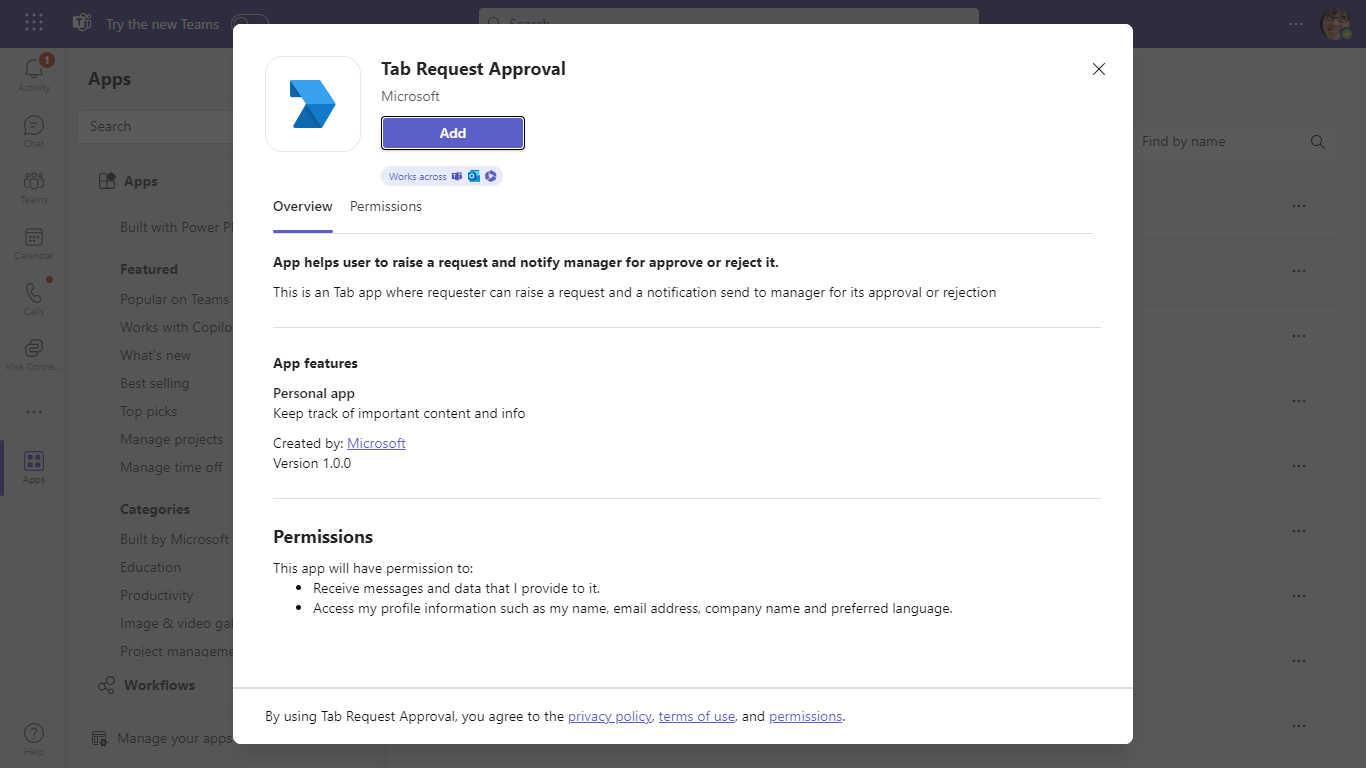
- Create Task
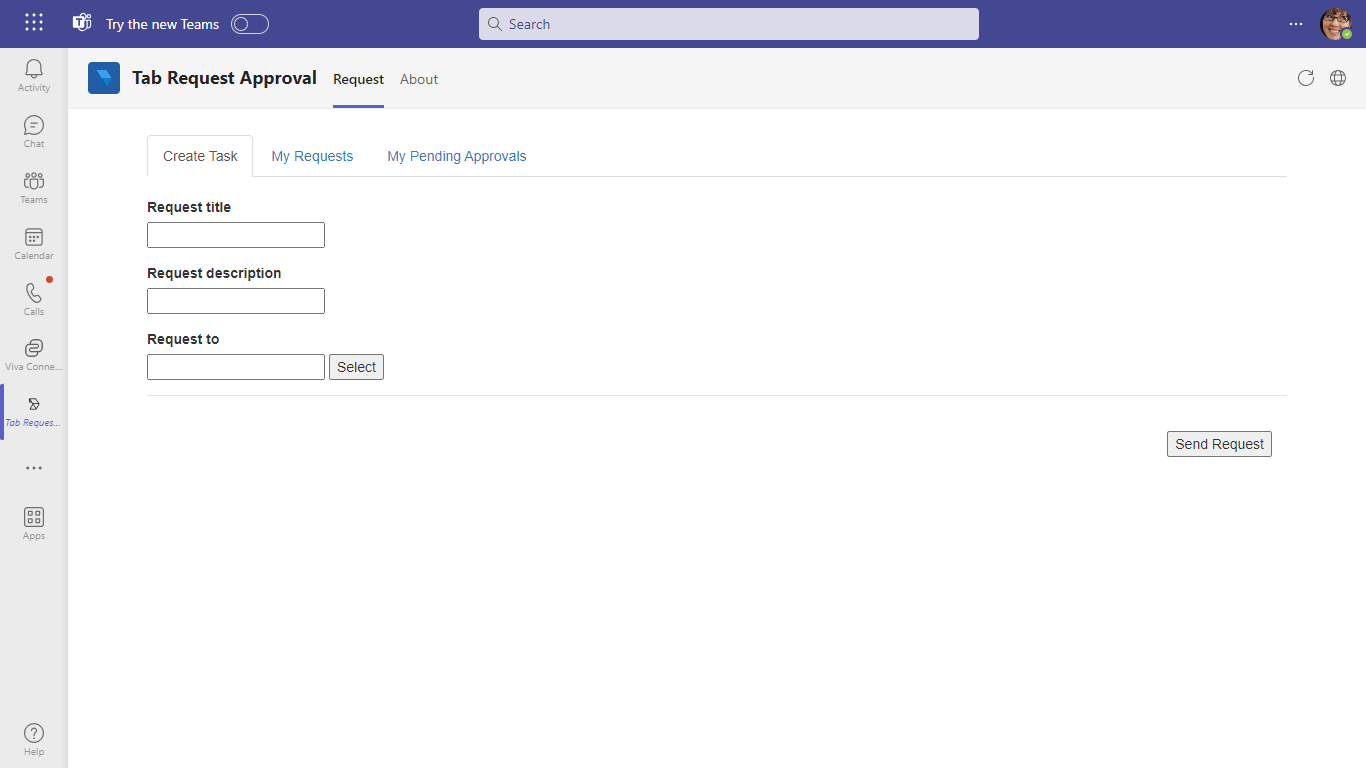
- Task Details
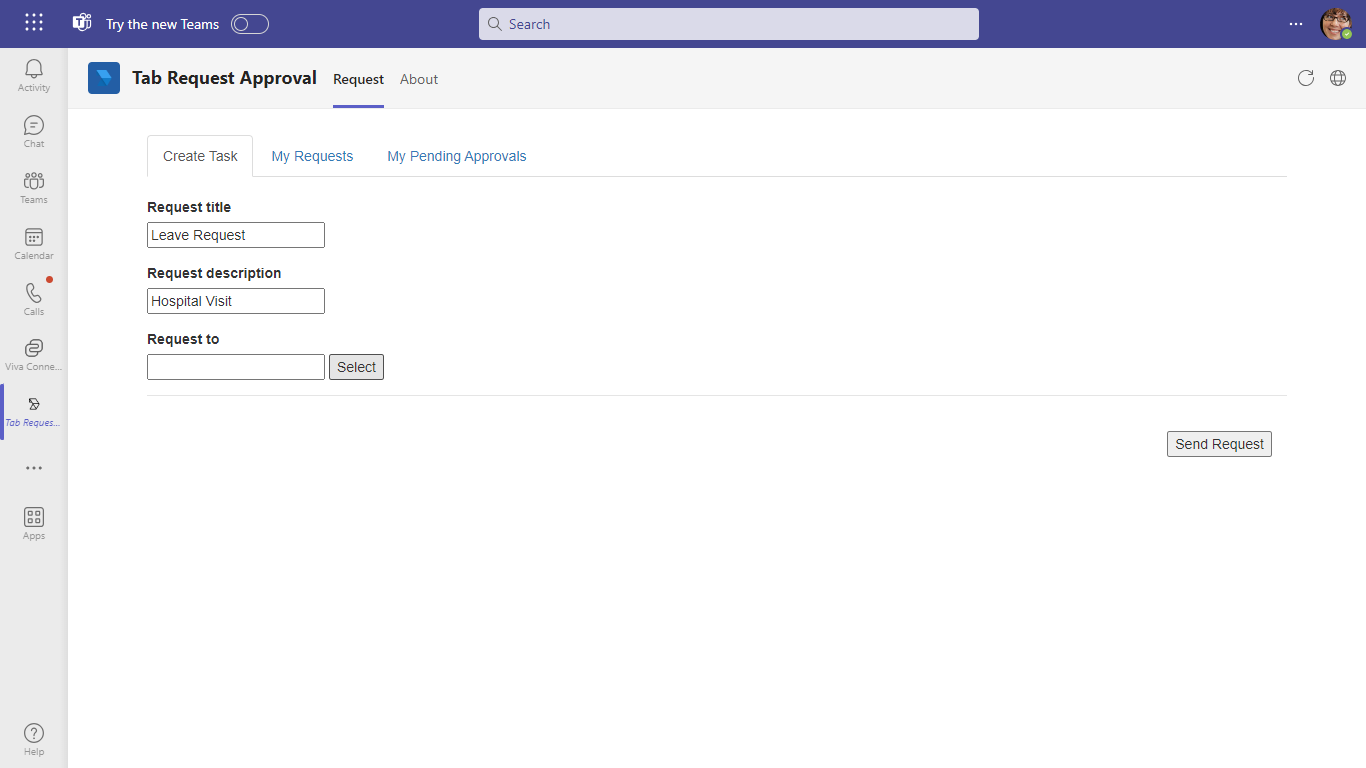
- All Person
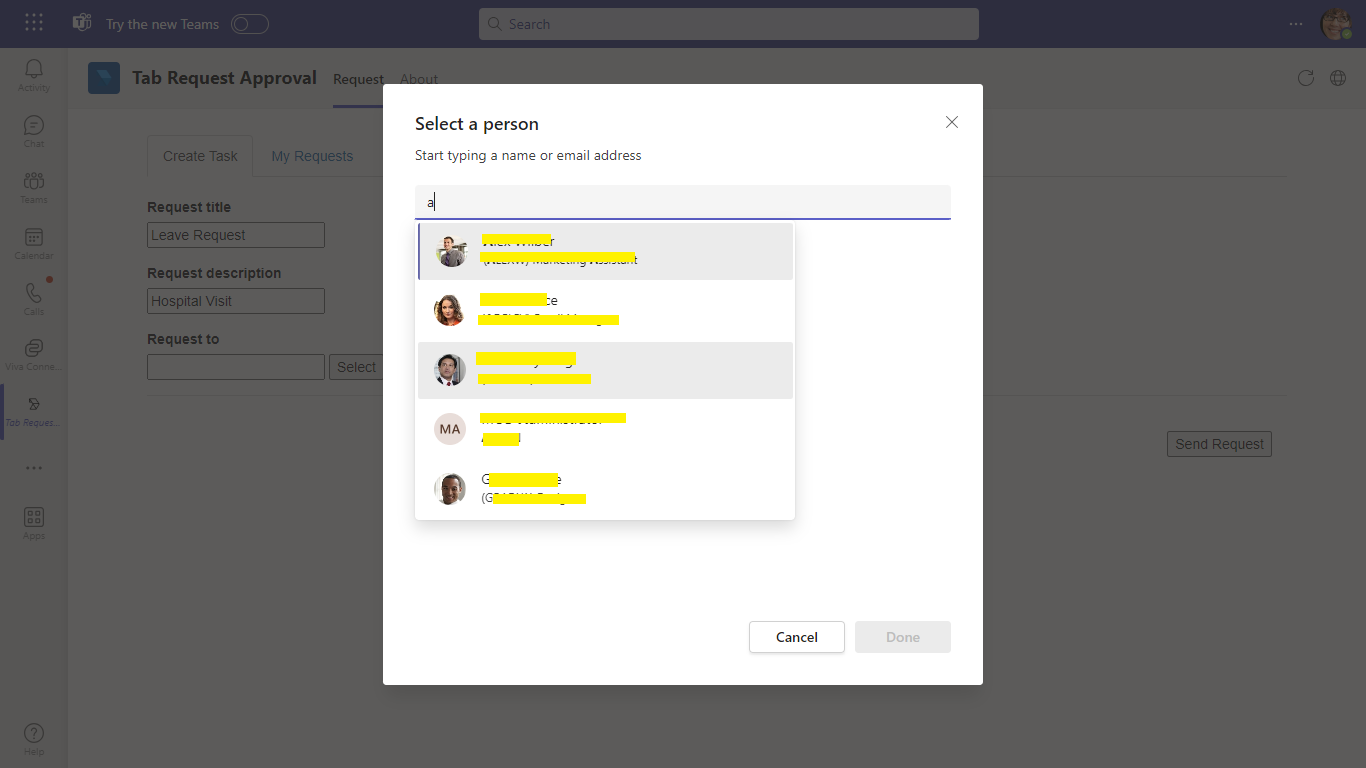
- Select a Person
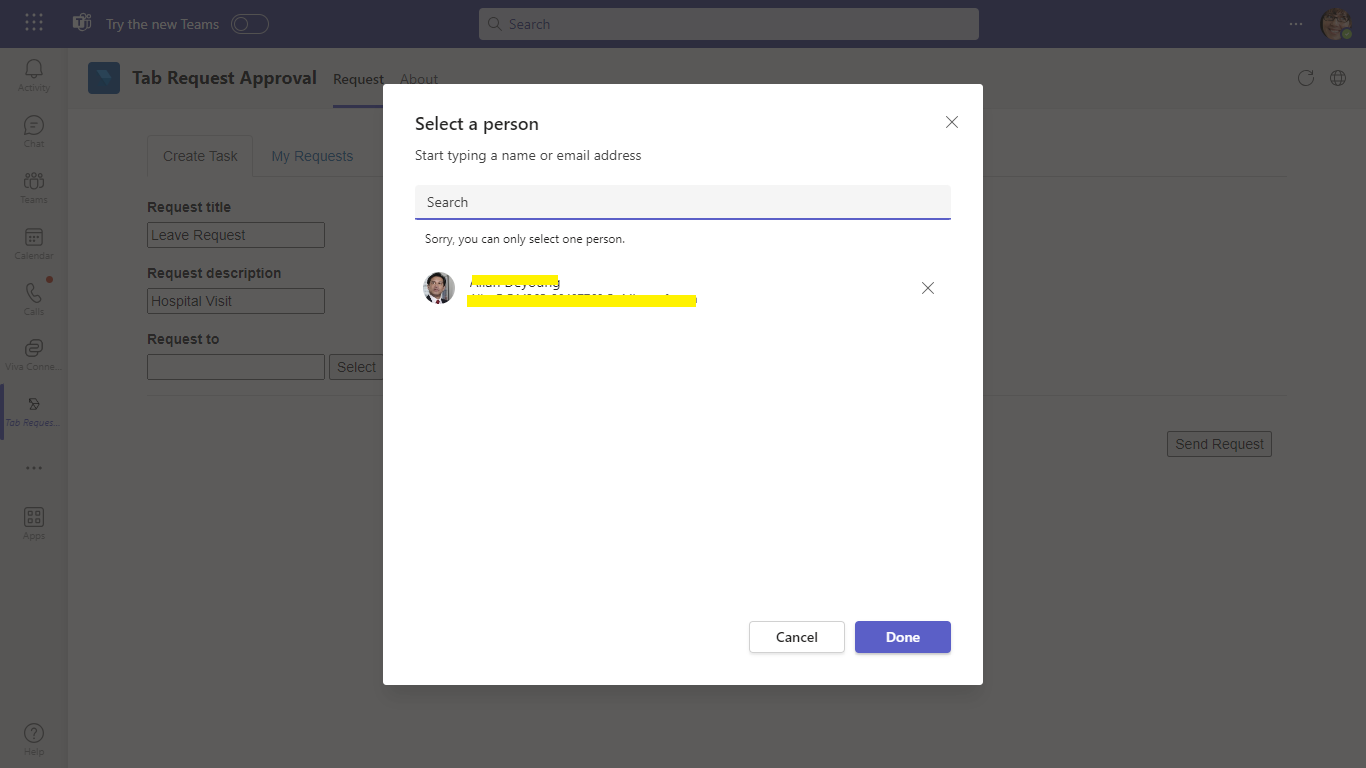
- Create task Details
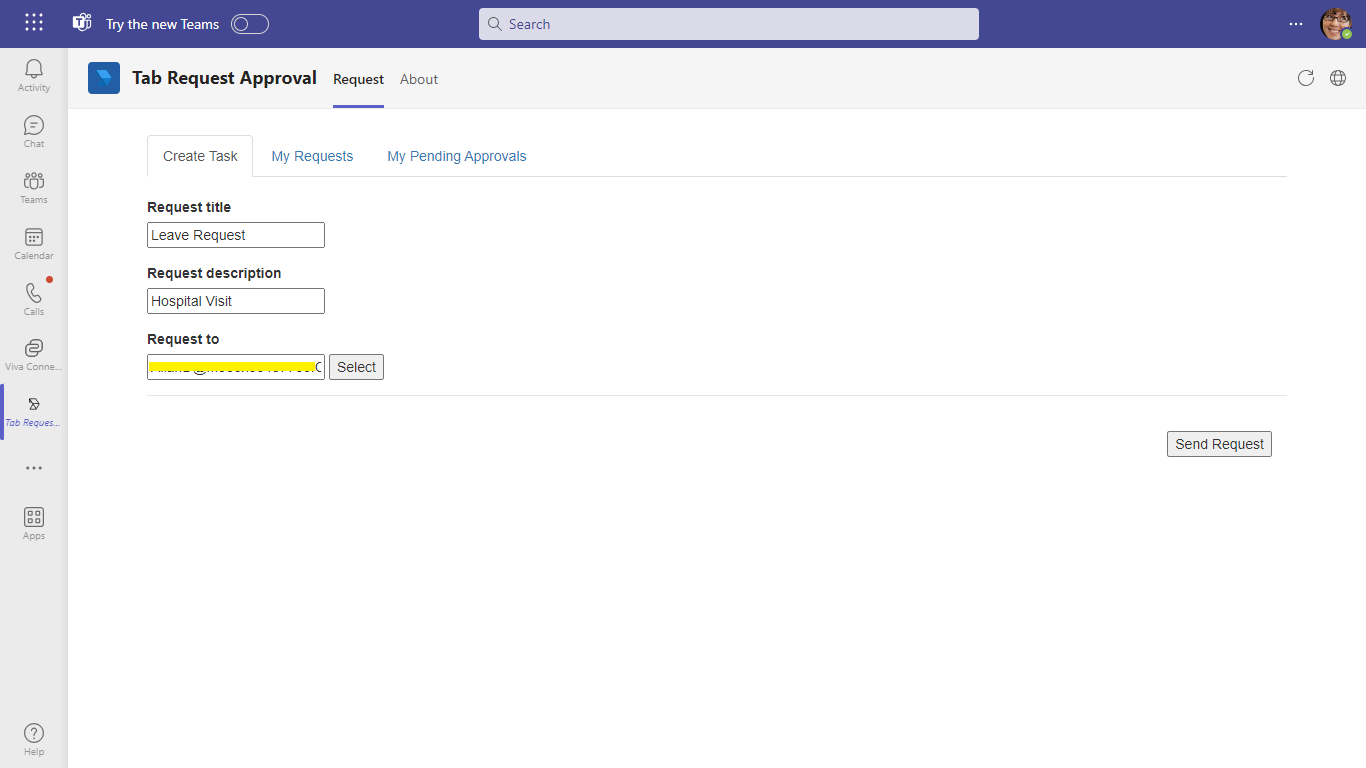
- Install App User-2
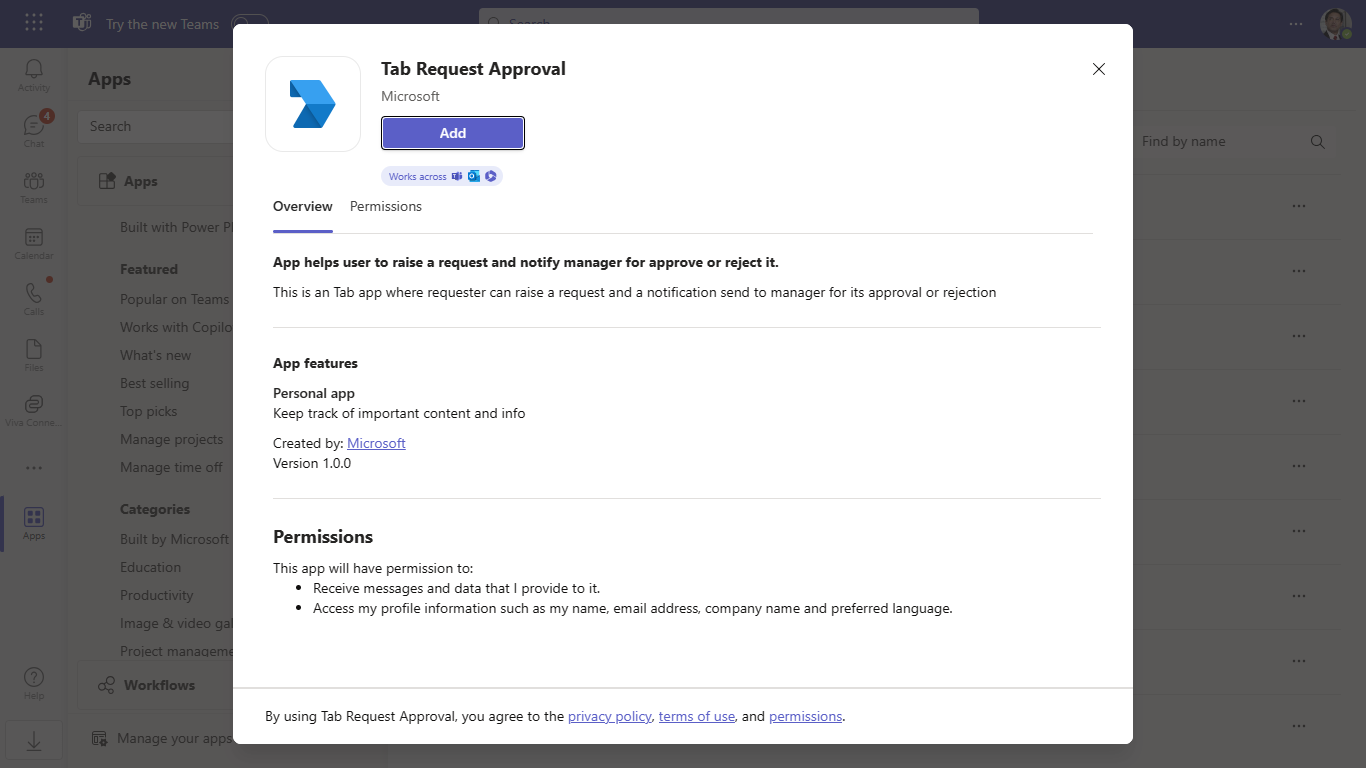
- Send Request
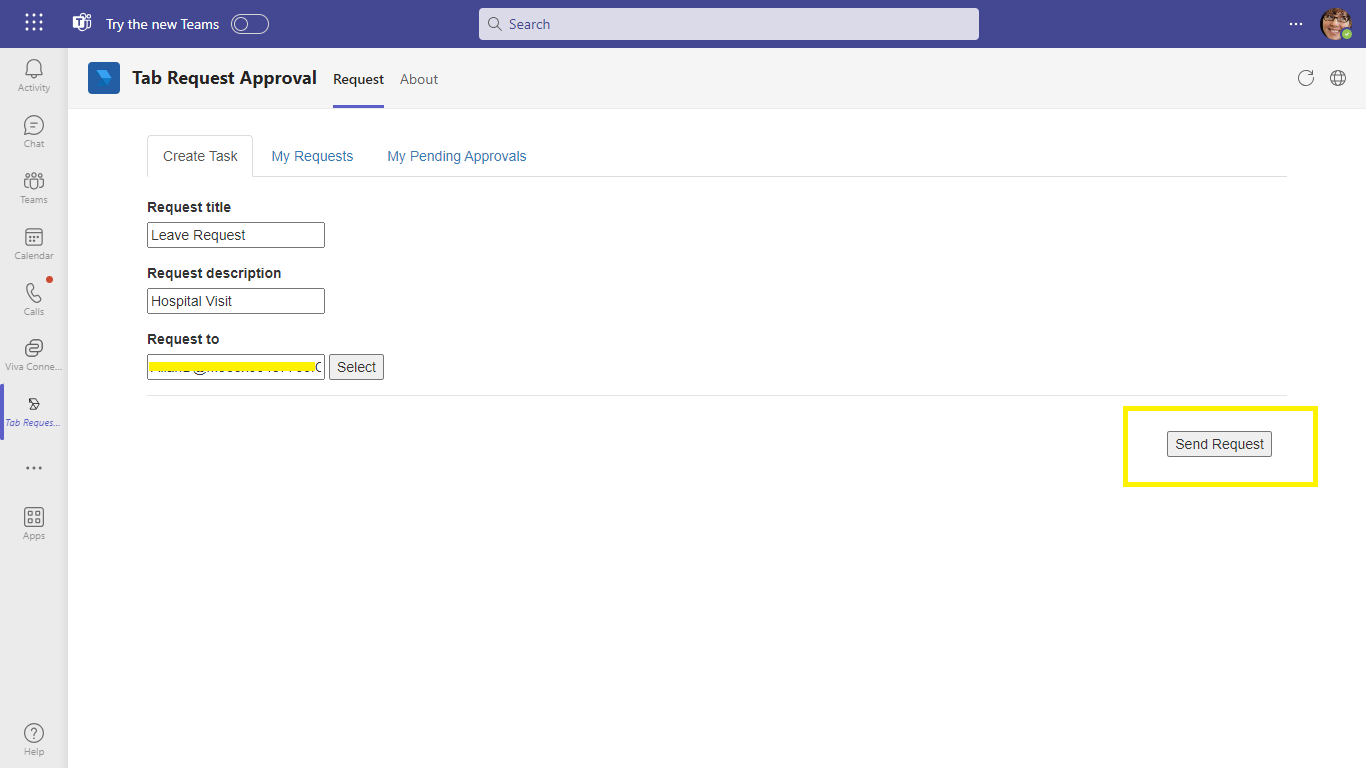
- On click of notification a task module will open, redirecting the user to the request.
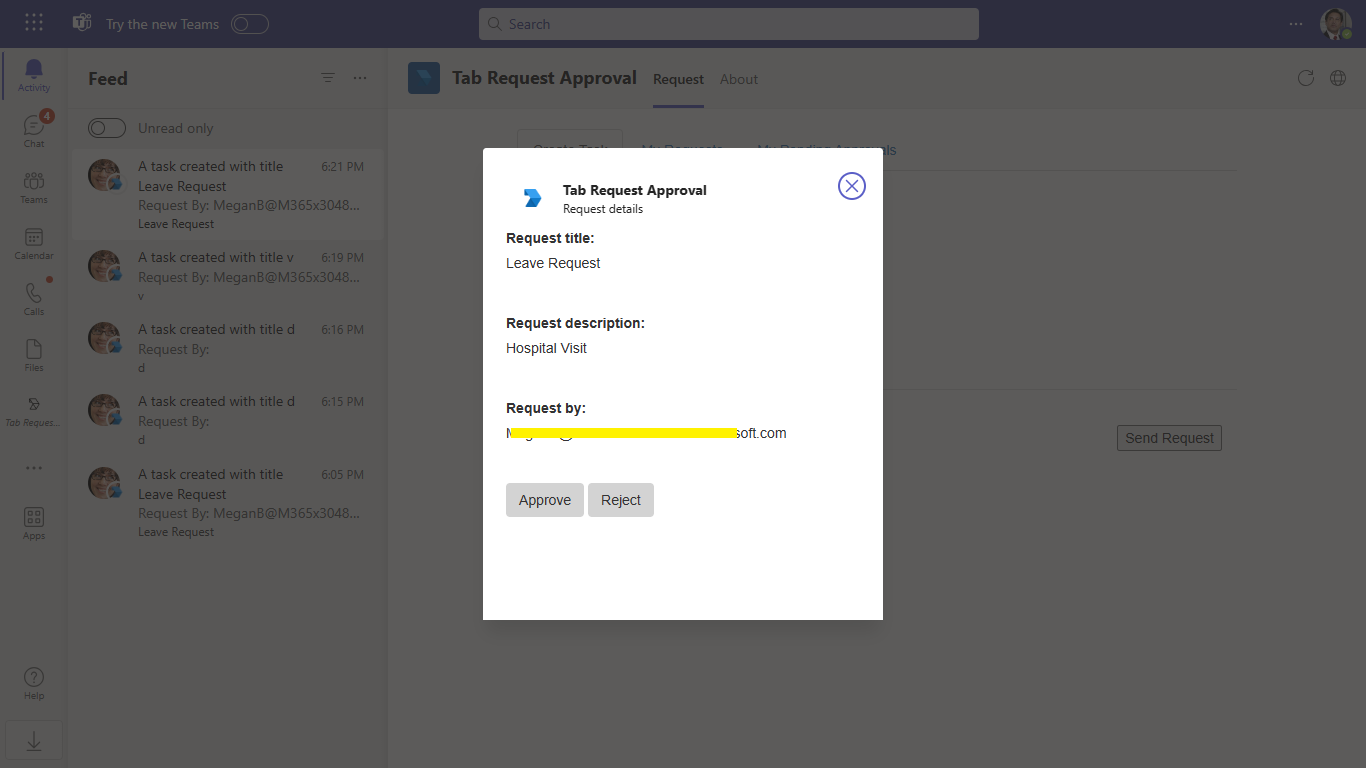
- User-1 My Request
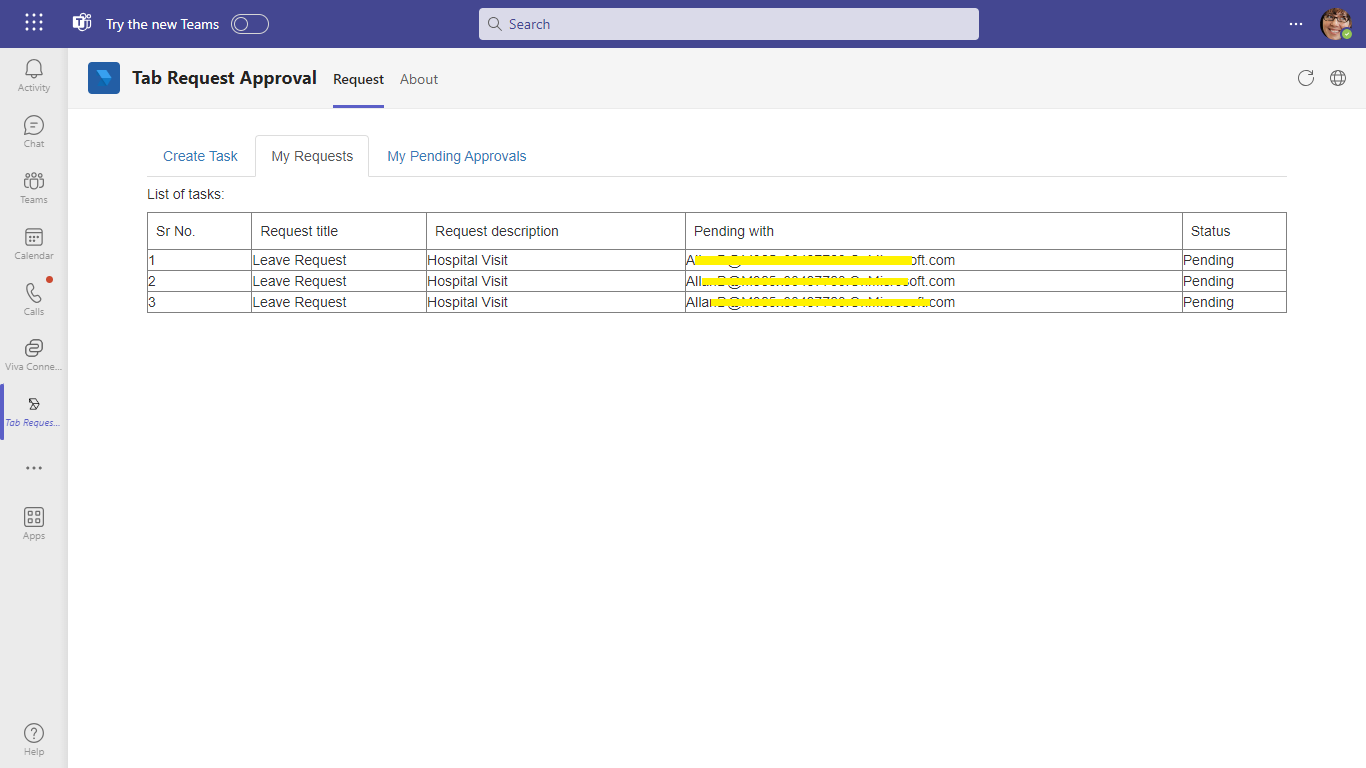
- User-2 My Pending Approvals
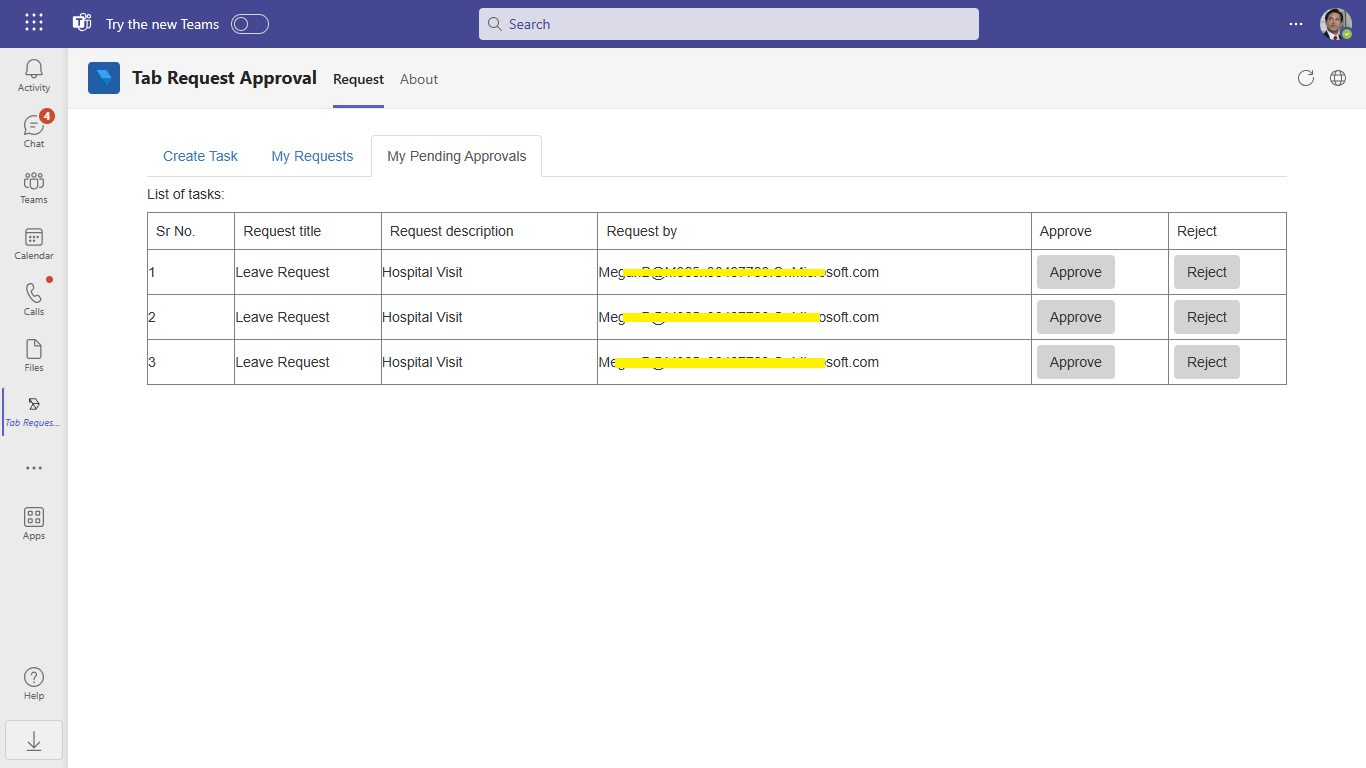
- User-1 Approved Status
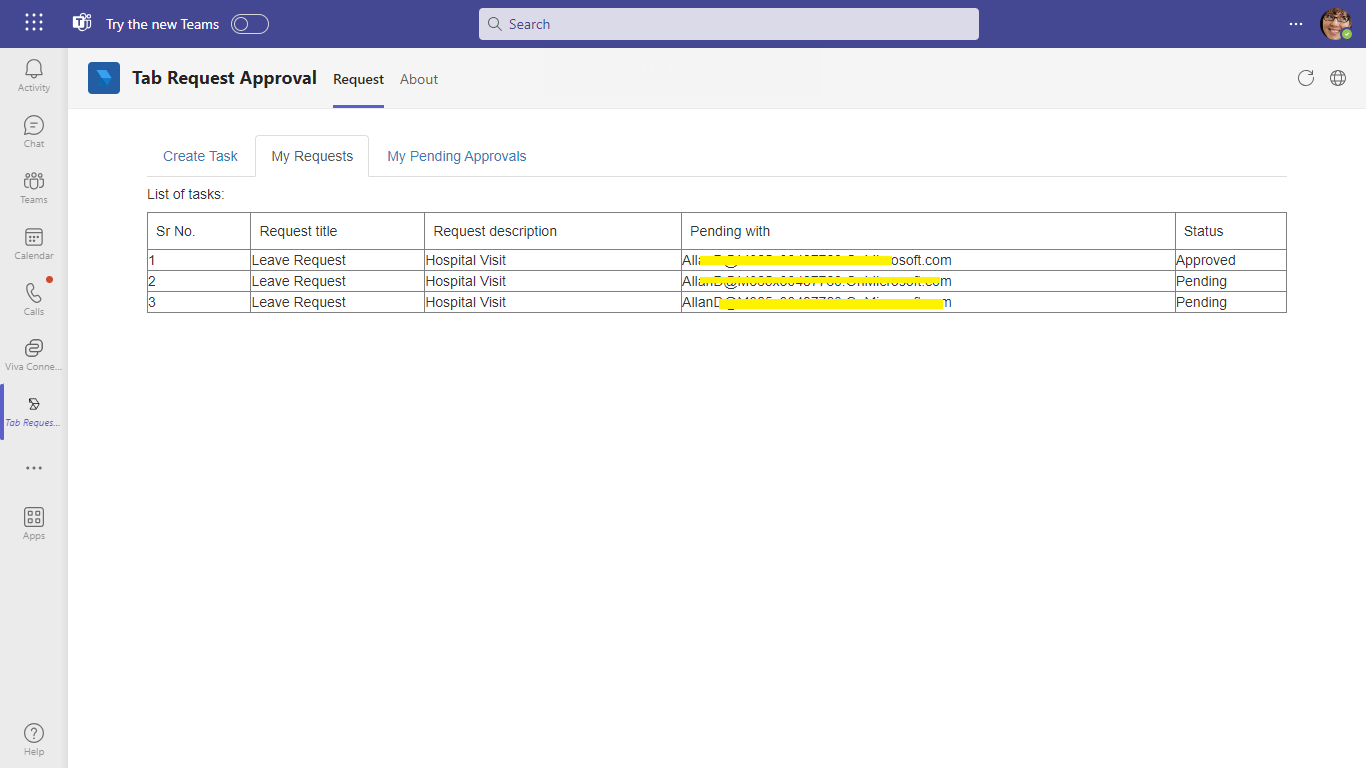
Further reading
- Create Personal Tabs
- Send Notification to User in Chat
- Send Notification to User in Team
- Send Notification to User